After focusing on bringing seed from hopper to soil, now is the time to evaluate soybean stands. Several issues can impair germination and emergence; however, not all of them affect yield potential. In some cases, action can be taken this spring to optimize soybean stands.
Herbicide Issues
What You See
- Sulfentrazone and flumioxazin herbicides are PPO inhibitors (Group 14).
- Necrotic lesions on cotyledons and the hypocotyl, malformed leaves, and occasionally death of the primary stem
- More severe in poorly drained, low spots in fields
- Acetochlor, metolachlor, dimethenamid, and pyroxasulfone herbicides are long-chain fatty acid inhibitors (Group 15).
- Heart-shaped leaflets
- Less likely to cause soybean injury than the Group 14 herbicides
- Metribuzin herbicide is a photosystem II inhibitor (Group 5).
- Interveinal chlorosis and necrosis on emerged leaves
- Symptoms occur on unifoliate and first trifoliate leaves, not later-emerging leaves.
- Risk increases in fields with high pH soils due to greater availability of the herbicide.
- Pendimethalin and trifluralin herbicides are mitotic inhibitors (Group 3).
- Swelling of the hypocotyl, reduced root growth, delayed emergence
- More likely in cool, wet soils where emergence is slowed, and more herbicide is absorbed by the emerging seedling.
- Mesotrione is a bleaching (HPPD inhibitor) (Group 27).
- New leaves initially turn white, then yellow
- More likely in soils with pH below 6.5 and low microbial activity due to dry or cool conditions
What You Do
- Don’t compare to corn fields – soybeans are more sensitive than corn to herbicide carryover.
- Take stand counts and document recovery over the next few weeks.
- Examine the apical bud- if severely damaged or the plant is girdled, it may not have full recovery.
- Avoid field operations that could place additional stress on the crop.
- Avoid tank mixes with flumioxazin + pyroxasulfone prior to heavy rains.
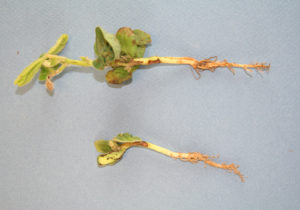
Figure 1. Image of soybean seedlings with flumioxazin damage. Photo taken by Travis Legleiter, Purdue University.
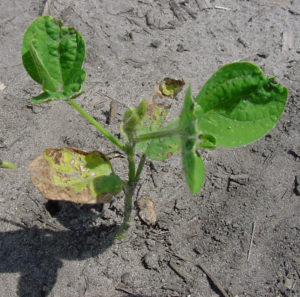
Figure 2. Image of soybean seedlings with atrazine or metribuzin carryover damage.
Sources:
Hartzler, B. 2017. Evaluating herbicide injury on soybean. Iowa State University. https://crops.extension.iastate.edu/. Anderson, M. and Hartzler, B. 2020. Identifying common herbicide symptoms in soybeans. Iowa State University. https://crops. extension.iastate.edu/blog/bob-hartzler-meaghan-anderson/identifying-common-herbicide-symptoms-soybean.
Cold Temperatures
What You See
Imbibitional Chilling
- Cold soil temperatures (less than 45°F) increase the risk of imbibitional chilling, which results in loss of seed vigor or death.
- Imbibitional chilling injury appears as layers of dead tissue on the cotyledons.
- Rehydration of cell membranes (imbibition) occurs 6 to 24 hours after seeds are planted depending on soil moisture and seed quality.
Early-Season Frost
- Water-soaked leaves, hypocotyls, or cotyledons appear 24 to 36 hours after temperatures between 28° and 32°F.
- Damaged plants eventually blacken and wither.
- Severely damaged plants may have girdled hypocotyls or dying buds.
What You Do
Imbibitional Chilling
- Wait to plant until soil temperatures are at least 50°F and forecasted to remain so for the following 6 to 24 hours. There may be a yield benefit to waiting and planting midday, rather than planting in the chilly, early morning and evening hours.
- Avoid planting 24 hours before a cold rain is forecasted.
Early-Season Frost
- Assess plant survival 48 to 96 hours after the frost event.
- If significant stand loss occurs from damage, replanting can be considered if the estimated yield potential of a replanted crop is greater than the yield potential of the existing stand.
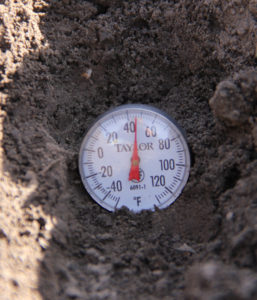
Figure 3: Monitoring soil temperature prior to planting can help avoid chilling injury.
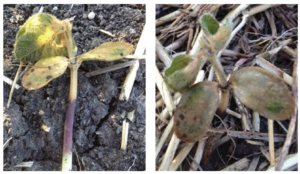
Figures 4 and 5: Water-soaked cotyledons may be visible about a day after plants are exposed to temperatures between 28 to 32°F.
Sources:
Specht. J., Rees, J., Elmore, R., Mueller, N., and Glewen, K. 2019. Soybean germination/emergence with April planting dates relative to coincident air and soil temperatures in April and May. University of Nebraska-Lincoln. https://cropwatch. unl.edu/2019/soybean-germination-tracking.
Licht, M. and McGrath, C. 2014. Imbibitional chilling and frost damage to corn and soybean seedlings. Iowa State University. https://crops.extension.iastate.edu. Bohner, H. 2003. Do soil temperatures at planting impact soybean yield? Ontario Ministry of Agriculture, Food and Rural Affairs.
Soil Crusting
What You See
- Planting into dry soil with rainfall or irrigation occurring too soon after planting can result in soil crusting and poor emergence.
- Fields with fine-textured soils, low organic matter, and little surface residue can be prone to crusting.
- During emergence, hypocotyls become swollen or break when trying to push through the crust.
- A broken hypocotyl usually results in seedling death.
What You Do
- Avoid excessive tillage.
- Apply irrigation (if it is required for good soil moisture) before planting soybean rather than immediately after planting.
- Use a rotary hoe to lightly break up the soil surface. Try to do this during the heat of the day when plants are less brittle and avoid tilling during the vulnerable ‘crook stage’.
- Plant the smallest-sized soybean seed in fields prone to crusting. Smaller seeds produce smaller cotyledons that may more easily lift out of the soil.
- Plant fields in 28- or 30-inch rows. With these row spacings, seed spacing within the row is usually close enough to help crack the crust and allow adjacent seeds to emerge.
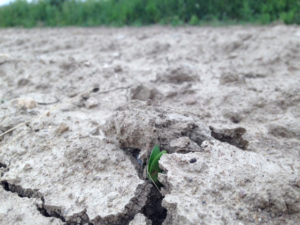
Figure 6: Occasionally, one or both cotyledons can be pulled off as the hypocotyl struggles to break through the crust. Having no cotyledons means the seedling will likely die; however, negligible yield loss is expected if only one cotyledon breaks off.
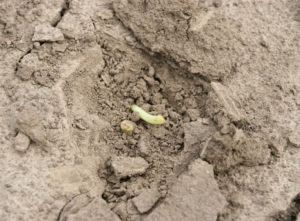
Figure 7: Seedlings with broken hypocotyls do not survive. Source: Shawn Conley, University of Wisconsin
Sources:
Staton, M. 2018. Improving soybean emergence in soils prone to crusting. Michigan Farm News. https://www.michfb.com. Conley, S. and Gaska, J. Delayed soybean emergence and cotyledon loss. University of Wisconsin. http://www.coolbean.info/.
Disease
What You See
- Seed rot (pre-emergence damping off)
- Death of seedlings as they emerge (post-emergence damping off)
- Seedlings dying in patches or individually
- Less vigorous plants or stand loss in areas that are compacted and/or poorly drained • Rotted roots make seedlings easy to pull from the ground.
What You Do
- Use seed treatments containing fungicides.
- Plant when soil temperatures are 50°F or greater.
- Use longer rotations, preferably to a non-host crop between soybean crops.
- Seedlings may be affected by more than one disease; consider sending injured and diseased seedlings to a diagnostic lab.
- Know which strains of Phytophthora are common in fields to determine the type of resistance needed in soybean products.
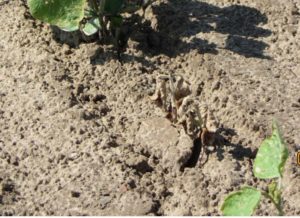
Figure 8: Symptoms of Pythium damping off may be observed as a loss in plant stand when seedlings die after emergence.
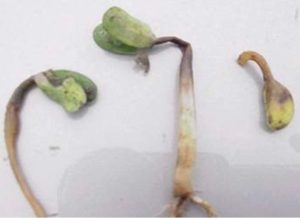
Figure 9: Early Pythium infection; soybean hypocotyls may become girdled or mushy, indicating disease.
Sources:
Wise, K., Bradley, C., et al. 2020. Soybean seedling diseases. Crop Protection Network. CPN-1008. Groves, C. and Smith, D. 2013. Phytophthora root and stem rot. University of Wisconsin-Madison. XGT1014.
Insects
What You See
- Seedcorn maggot feeding on sprouting seeds and tender seedlings in soils with high organic matter and longer periods of cool, humid weather
- Overwintering bean leaf beetle feeding on cotyledons, stems, and foliage
- Early-season soybean aphid damage
What You Do
- Use a seed treatment insecticide.
- Assess foliar feeding in 5 areas of the field. Determine the average percent of defoliation, the degree of cotyledon/stem damage, and if the growing point is severely damaged or killed.
- Scout the field to determine the number of insects per plant.
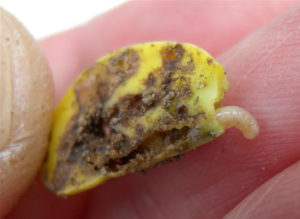
Figure 10: Seed corn maggot is a threat to early stands.
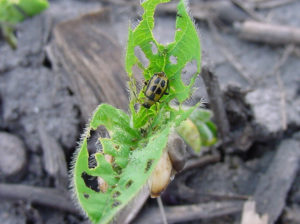
Figure 11: Foliar or cotyledon feeding injury may indicate the presence of bean leaf beetles or aphids.
Source:
2009. Bean leaf beetle. Purdue University. Field Crops IPM. https://extension.entm.purdue.edu.
Planter Issues
What You See
- Restricted lateral root growth, slower nodulation, seed slot opens and exposes seed
- Slow emergence, long hypocotyls, cotyledon energy is spent by the time of emergence
Caused By
- Seed planted into wet soils with too much down pressure on gauge wheels
- Planting deeper than 1.5 inches
What You Do
- Squeeze a ball of soil in your hand. If it crumbles after being squeezed, this indicates that the field is dry enough for machinery.
- Set your planting depth anywhere between 0.75 and 1.25 inches.
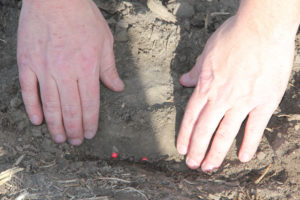
Figure 12: The planting depth for soybean should be 0.75 to 1.25 inches.
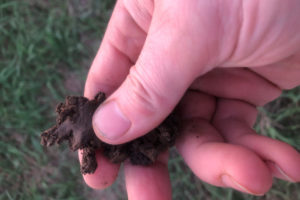
Figure 13: A ball of soil that crumbles after being squeezed in your hand indicates a field is dry enough for machinery.
Article Link – Soybean Germination Issues
